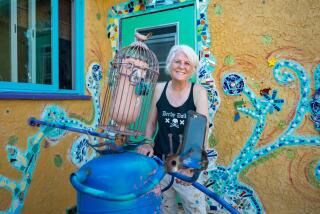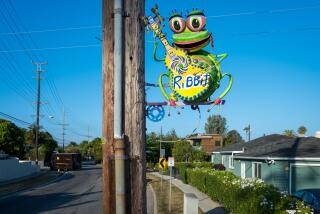DILEMMA OF PUBLIC ART IN SAN DIEGO
SAN DIEGO — Last week’s surprise announcement that artist Ellsworth Kelly had refused to go ahead with a controversial sculpture commissioned for San Diego has raised questions about the processes used for placing public art in America’s Finest City.
The decision by Kelly, a world-renowned minimalist artist from New York, not to sign a contract with the San Diego Unified Port District was apparently generated by negative reaction to the artist or his design, including critical letters to newspapers that continued after the Port Commission approved the sculpture.
Kelly’s withdrawal came two months after a 5-1 vote by the Port District Board of Commissioners in favor of the proposed 65-foot stainless steel monolith, a vote that seemingly had put the issue to rest.
Kelly still will not talk about the stainless-steel monolith. Contacted in New York, he said, “I would prefer at this moment not talking to reporters about it.”
But according to his dealer, Joseph Helman of the Blum-Helman galleries in New York, Kelly’s decision was based on several factors, the strongest being his integrity as an artist. Kelly ultimately didn’t feel that he would be satisfied with the single piece the Port District approved. “When he reflected on it, he realized it wasn’t really what he wanted,” Helman said.
Nor did Kelly respond well to the negative public reactions here. “He doesn’t want to make people angry, and he doesn’t like being subject to a popularity contest,” Helman said.
“Most artists would live with the contract he got from the port, but Ellsworth did not feel he could be responsible for the fabrication (as the contract required). He felt that, for a piece that large, the structural control was outside of his expertise.”
The sudden reversal shocked Kelly’s supporters here and raised the question: Whither public art in San Diego?
“I was appalled,” said Lynn Schuette, director of the Sushi performance gallery and a member of the county’s Public Arts Council Committee. “The whole city should have its tail between its legs. It’s incredible, to have hounded an artist of that stature into resigning. I don’t blame Kelly as an artist. I would have said this is not worth the hassle. To let a minority (of the community) have that kind of power is amazing.”
Gerald Hirshberg, chairman of the Port District’s art advisory board, which backed the choice of Kelly, also commented on the aggressive criticism, which included the testimony of young children, local artists and art dealers who told a Port District hearing that the Kelly work would ruin Embarcadero Park.
“It would seem to me that if the city has an aspiration of being a cultural center, we have to be aware of the effect of overwhelming negative reactions over a long period of time on artists being able to express themselves,” Hirshberg said. In Hirshberg’s opinion, the criticism was excessive.
Many people attacked not only Kelly’s abstract minimalism but also the advisory board’s composition and the process it used to select Kelly.
“I feel the port now will address the public’s concerns about the process being open and fair,” said Leslie Jones, a gallery director who led the forces opposing the port’s selection process, and whose child testified before the Port Commission. Jones’ chief complaint is that an open competition was not held for the commissioning of the work and that locations and times of advisory board meetings were not readily available to the public.
The Kelly sculpture, a $325,000 spire to have been situated on the waterfront near the Hotel Inter-Continental, is not the only thing to have prompted questions about the methods of commissioning public art.
In 1982, the county Board of Supervisors selected a design for a 35-foot sculpture to be placed at the East County Regional Center in El Cajon. After a national competition in which artist James T. Russell of Redondo Beach was selected, the board reversed itself and voted 3-1 to spend the money--about $90,000--on a power plant. The money for that artwork was dedicated through a county policy in which 1% of the first $500,000 and 0.5% of the remaining cost of a building be allocated for artworks to be purchased for the building.
In 1984, Russell filed a breach of contract claim against the county. Supervisor Paul Eckert, who voted against Russell’s sculpture, admits he did not like it. Now he supports reinstating Russell’s artwork. Although the Board of Supervisors acted against its advisory board’s advice, Eckert says such boards are essential to the process. According to Schuette, who is on the county’s advisory board, “These advisory boards should be a combination of artists, art professionals and what, for a better term, I call normal people. That creates a nice balance. When there are those who haven’t been educated in the arts, they learn a lot, and the artists have to articulate their thoughts better.”
In another public art contretemps, artist David Beck Brown was stymied by the Metropolitan Transit Development Board in a bid to place a sculpture at a transfer station of the San Diego Trolley. Brown approached the MTDB last spring with his proposal and was told to come back after he received endorsements. He returned with a string of endorsements including ones from the county’s Public Arts Council Committee and the San Diego Public Arts Advisory Board (PAAB).
Instead of voting on Brown’s sculpture, it put out a request for proposals in July to see what designs other artists might submit for the same site. Brown was the only artist to submit a proposal. Two weeks ago, by a 7-7 vote, the MTDB effectively brought an end to Brown’s quest.
In the absence of an in-house art advisory board, the MTDB members relied primarily on their own artistic tastes in considering Brown’s sculpture.
Virtually all players agree on the importance of government bodies having an advisory board that includes some experts. “You try to put together a group of people with a varied background, so that they run the spectrum from the traditional to the contemporary,” said Councilman Bill Cleator. “We should not lean toward just one segment of art. The advisory board is extremely important. I don’t think there’s anybody on this council capable of choosing good art, and that includes myself.”
David Avalos, an artist associated with the Centro Cultural de la Raza, puts it slightly differently. “The worst thing is to put (art selection) in the hands of politicians, because they tend to be conservative and they make their way by telling voters what they want to hear,” Avalos said. “The important thing for the politicians is to make sure that the processes are open and no one is discriminated against.”
More to Read
The biggest entertainment stories
Get our big stories about Hollywood, film, television, music, arts, culture and more right in your inbox as soon as they publish.
You may occasionally receive promotional content from the Los Angeles Times.










